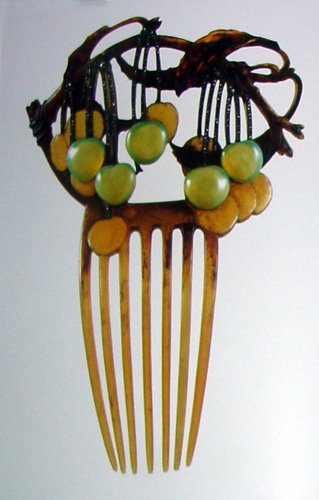This beautiful deep-red garnet tiara, c.1880, set in a leaf design to a handmade gilded silver frame sold for 895 GPB today at Rowan and Rowan. Lovely.

Some Lovely Things on Ebay
There have been some beautiful things sold on ebay recently.
A beautiful tortoiseshell, gold makie, and coral kogai stick from the Edo period sold for $490 on Nov. 28. You may refer to Auction #300174753664.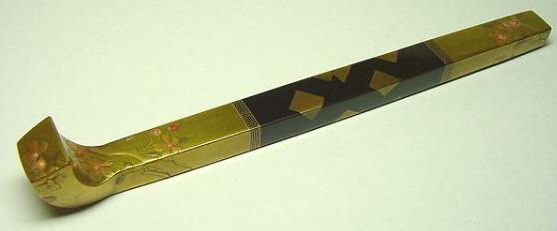
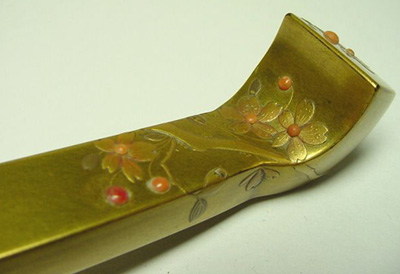
A Showa tortoiseshell kushi with two layers of leaves flowing in the wind sold for $257.82 on Nov. 25. You may refer to Auction #330189054886.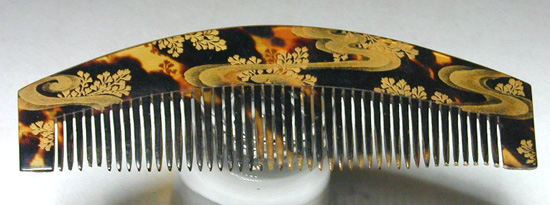
A gorgeously carved Victorian ivory comb went for the stunningly low price of $86 because two pieces of it were missing. When such a beauty, with no discoloration, has damage, I hold my head in my hands. Anyway, it was a great bargain, and a beautiful comb. You may refer to Auction #230197013812.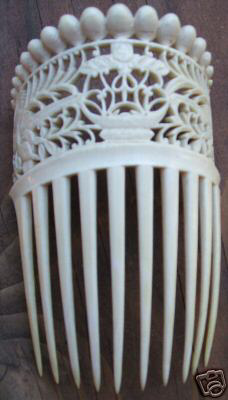
A beautiful 14K rose gold hair pin sold for $383 on Dec 6. You may refer to Auction #250193680625.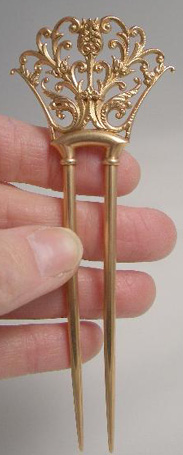
On Dec 10, this matching set of beautiful garnet butterfly hairpins went for $760. You may refer to Auction #170174938274.

This beautiful late Edo tortoiseshell kanzashi, c. 1850, sold for an excellent price of $152.53 on Dec 9. The pins are smaller because it was made to be worn at the front of the geisha’s wig. The quality of the shell is translucent blonde and extraordinary. You may refer to Auction #110201844429.
And finally, I bought this butterfly ivory comb on Ruby Lane recently for $245. It looks pretty discolored, but no pieces are missing, and I loved it, so c’est la. Update: I received it. It’s not discolored at all, and it’s huge. I’m thrilled with it.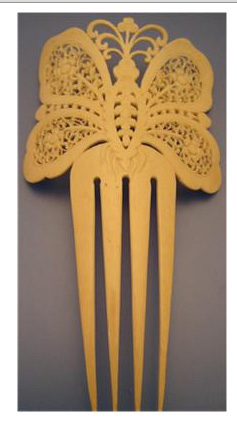
Alexandre de Paris
Very rarely will you see an ebay post for a modern hair ornament of this brand. When it does come up, they try to mimic the retail price, which no one will pay on ebay because no one really knows or has any emotional attachment to this brand.
Why? The only place you can buy these ornaments are in Paris, New York, Tokyo — in store. The company has no online presence whatsoever. No layaway, no mailing list, no messageboards, no notificiations of new items, no website, NOTHING!
I’ve been yelling at Jovy (the New York store manager) for years about this. She had a website up briefly, but then it came down. I can’t even get a picture of one of the couture ornaments I die for mailed to me, so I haven’t bought anything in years. However, when a site was briefly up, I did collect some pictures and put together a collage so you can see the handmade beading, fabric art and design that goes into these pieces. They are hand made by atteliers in Paris, so they qualify as haute couture hair pieces.
The real Alexandre de Paris was a hairdresser to the stars. Among others, he did Elizabeth Taylor’s hair when she filmed Cleopatra, and I really think this company’s designs are the heir to Auguste Bonaz’s great art deco combs. So picture 1 is my collage from a catalog long ago, where nothing pictured is remotely available. Picture 2 is my personal collection, which hasn’t been added to in years, but which of course looks like a total mess laid out on my glass vitrine ;-). They are kept in a vanity drawer.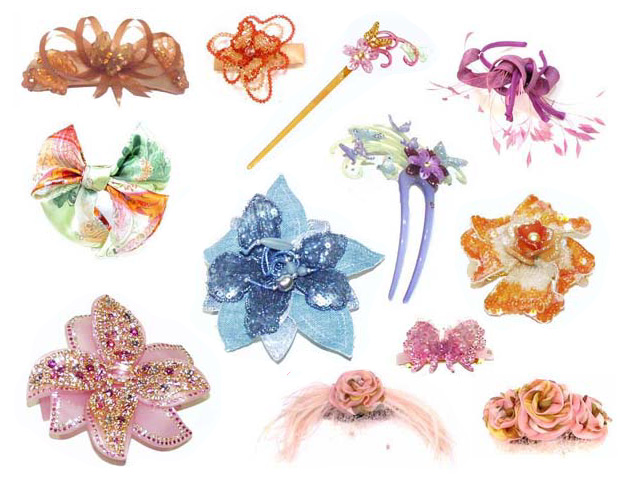
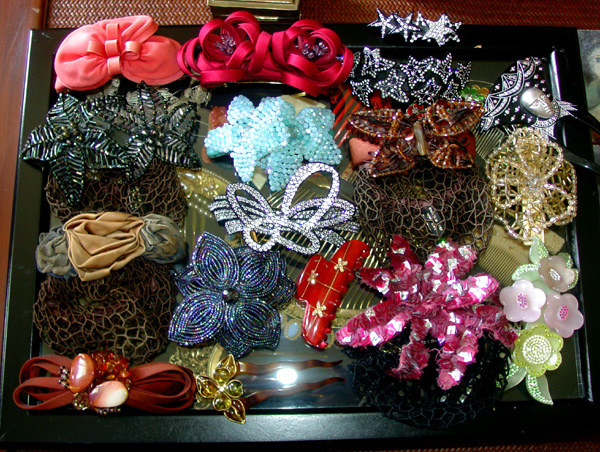
PATOROMU TAMATEA
Patoromu Tamatea was of the Ngati Tamateautahi, a sub-tribe of Ngati Pikia. He carved canoes. When that work ceased in 1864, he was involved in settling a dispute over pigs. In later life, he started carving wood items, including combs, for British Captain Gilbert Mair. Many of his carved figures are now in the Auckland Museum and in the Museum of New Zealand.
“Heru” is the Maori word for ‘comb.’ “Heru paraoa” means whalebone comb. In Maori culture (which has strongly informed developing NZ culture) a person’s head is “tapu,” or sacred, prohibited, restricted, under protection. The higher the rank of the person, the more tapu their head. Therefore, anything that came in contact with the head (like combs) was also tapu, and had to be treated with great care.
One of Tamatea’s combs just sold on ebay for $1825. I think if this went at Sothebys, someone would have paid over $10,000 for it.
I have rarely seen anything with this indelible level of drama, passion, boldness, inspiration, and courage. This is an unqualified masterpiece, expressing the soul of a tribal god. It was a privilege to see it. Made of bone, c. 1870, the inlay is native paua shell. The face exists on both sides of the comb. I also found another comb by this same artist, as well as a link to the wooden carving of the Madonna and Child, both of which are housed in the Museum of New Zealand. Mr. Tamatea died in 1890.

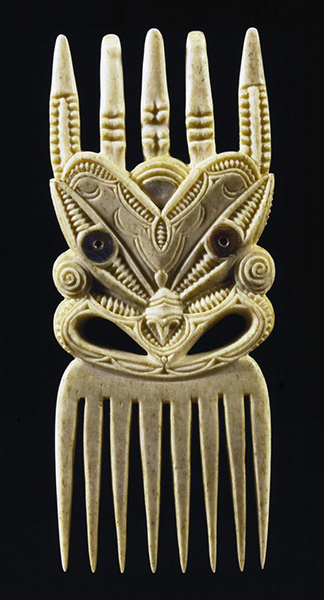
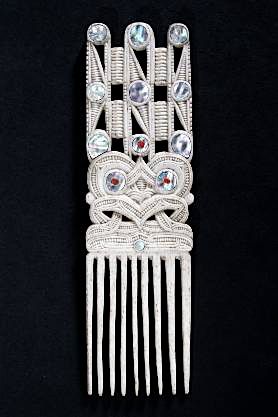
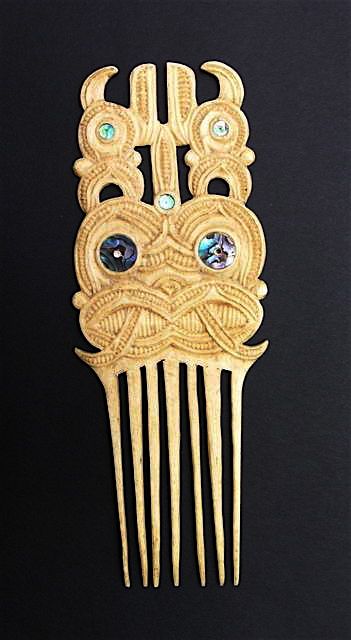
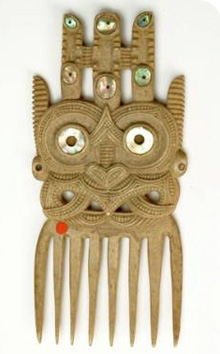
Kind Hearts and Coronets
This peeress coronet was made for a countess, the wife of an Earl, to be worn at the coronation of Edward VIII. It was made in London, 1936, for the coronation , which was planned on the 12th of May, 1937. However, Edward abdicated in December 1937 to marry divorcee Wallis Simpson, and the coronation never took place.
The coronet would presumably have been worn at the coronation of his brother George VI later in 1937. It is made of a circlet of silver, gilded, with eight strawberry leaves and eight balls on raised points denoting the rank of Earl. It is lined in crimson silk velvet with gold tassel and trimmed with ermine around the base. It was designed to be worn on the top of the head, usually in conjunction with a tiara, so is 16 cm [6.25 inches] in diameter and 16 cm [ 6 .25 inches] tall.
This text and image must be credited to Rowan and Rowan, a shop in London that has fabulous things, most notably cameos. I have bought two things from them, but I missed this by minutes! Argh!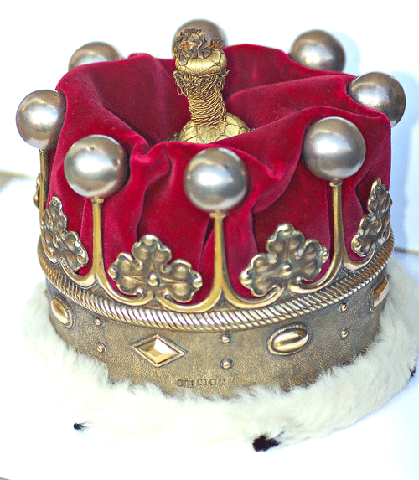
The Combs of Elizabeth Bonte
Inspired by Lalique, Mme. Elizabeth Bonte was a French jewelry maker who specialized in horn pendants. She merged her workshop with her rival George Pierre, and they made art nouveau jewelry until 1936. Both did much to popularize horn jewelry in France at the turn of the Century.
This comb shows two cicadas on a flowering tree branch. It’s made of engraved horn, heightened with color, and is selling at the Tadema Gallery in the $5000 to $10,000 range. c.1900.
This comb of flowers with subtle shadings is also engraved horn. Signed, E. Bonte, c. 1900, it is selling at the Tadema Gallery in the $1200 to $2400 range. Both combs appear in Bijoux et Reliures-Artistes du XXe Siecle La Bibliotheque des Arts-Paris 1992.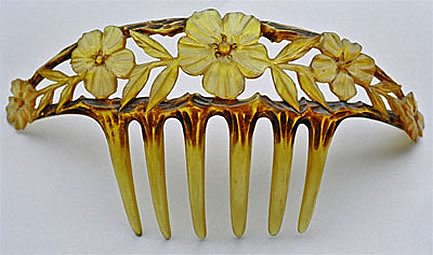
What A Difference A Century Makes
Sothebys is having an auction of magnificent jewels, and as I was looking over the tiaras, I couldn’t help but be struck by the contrast between one made in 1870 and another made in 1970.
The Victorian tiara is made of open work panels of stylised Greek key and foliate scrolls, whereas the 70’s piece is a hinged crescent of elongated panels. What a difference a century makes. However, I have to admit, I totally see a Star Wars Princess in that 1970’s tiara. ;-)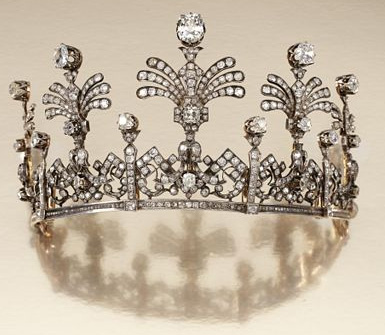

Some Lovely Things on Ebay and Beyond
This delicately carved blond tortoiseshell comb with 18-karat gold pique, c.1890, sold for $258.88 on Nov. 11. You may refer to Auction #220168340896.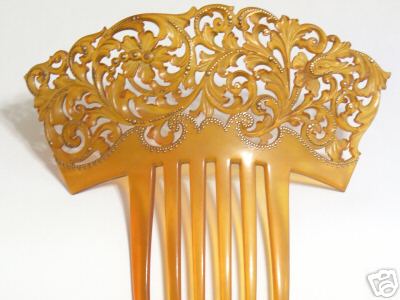
This beautiful blond tortoiseshell hairpin with 14-karat gold decoration and a bar of sapphire and diamonds attached, sold for $229.38 on Nov. 11. You may refer to Auction #220168352193. I thought this one was ridiculously underpriced. I wonder where everyone was.
This Meiji gold, silver, and coral bira bira kanzashi went for $305 on Oct. 22. You may refer to Auction #300161851114.
I’m buying this Japanese silver, gold plate, and black enamel Showa set from Shigeru’s brother in Japan. I liked the 3-dimensional quality of it. Lotus flowers in a pool of water.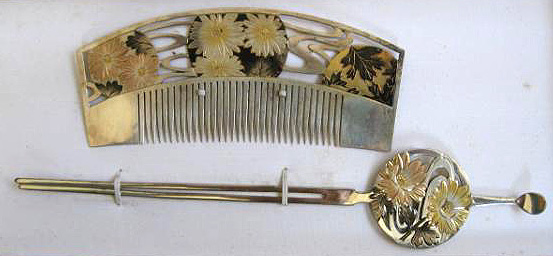
I’m also in installment payments to buy this, a total Barbara piece. It’s Regency, c.1820, a floral spray with rhinestones. One of those flamboyant things I had to have, or I’d die. But it seems I’m that way with everything I love. When the Prince Regent, George, stepped in after his father George III went mad in 1811and then ruled from 1820 – 1830, England named the fashion period, Regency, after him. 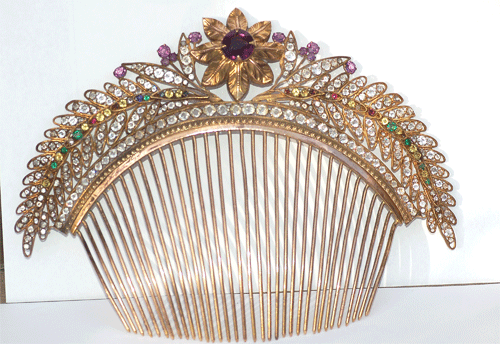
Tiara Leaves
During the Victorian period, archeological discoveries in Rome and Greece captivated the imagination of jewelers. Leaves found on ancient headpieces became a favorite ornament in tiaras. Here are four lovely examples.
This French tiara, c. 1820, is set in a patterned, gilded frame with faceted crystals. It depicts a spray of hyacinth leaves with raised flower buds. It sold last year for 1000 GBP from a dealer in London.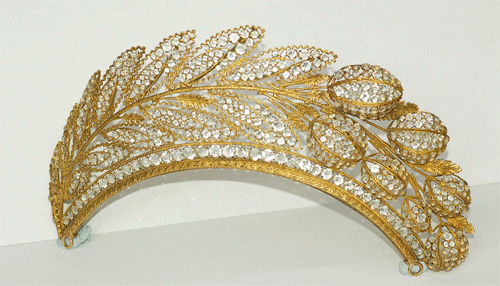
This English gilt metal tiara and brooch has flowering sprays of myrtle. On the blue velvet cushion that came with it, silver thread was embroidered to read “d.11ten Januar. 1867.” It sold at Sothebys in London for 4,320 GBP.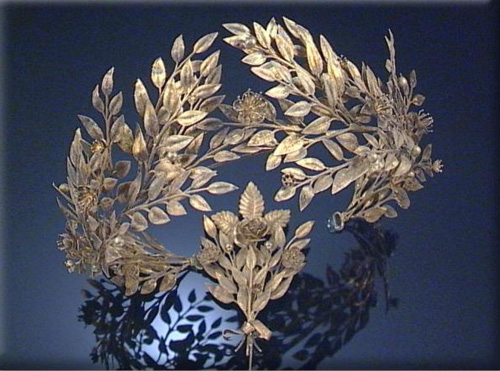
This Castellani Archeological Revival Gold tiara, c. 1870, is a simple gold branch bearing sprigs of olive leaves, with circular openings at either end for ribbons. It was exhibited at The Bard Graduate Center in New York, Somerset House in London, and Villa Giulia in Rome, and sold for $19,200 at Sothebys.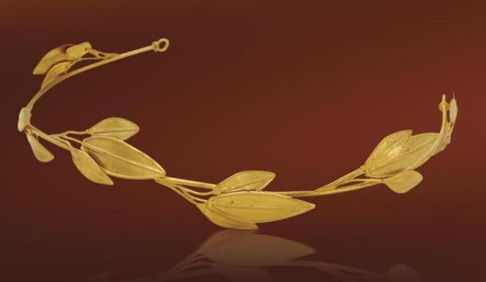
Last is this diamond tiara, designed as a spray of fern leaves set with cushion-shaped and rose diamonds. The fitted case is by J & P Bapst & Fils Joalliers, 25 Rue du Faubs St Honore, Paris, c. 1870. Sale Price: 82,700 GBP at Sothebys.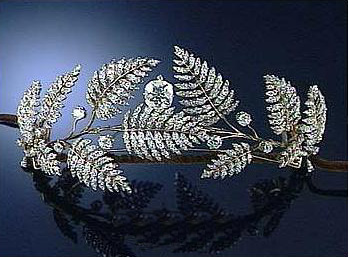
Cherry Blossoms
Lalique, c.1903, dyed horn, featured at the exhibit in Hakone, Japan. It was compared to a number of Edo combs, which had exactly the same kind of cherries painted on them.